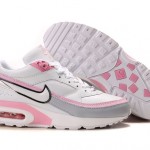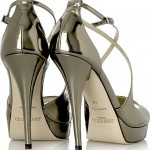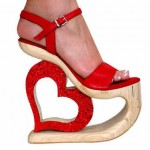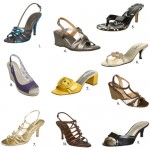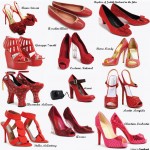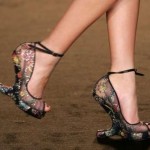By and large I’m quite empathetic and patient about female characteristics, notably emotional foibles, but there are outer limits to the level of understanding the male sex can display towards our female counterparts, and indeed, vice versa. I’ve even blogged about the pressure women come under to conform to the norms of the fashion industry. Chocolate? We all need our comfort foods in stressful times! Retail therapy? Why not?!
No, the thing I find difficult to understand is the female obsession with footwear. We all need to wear shoes, of course. I have maybe half a dozen pairs I wear with some degree of regularity, appropriate to my clothes and the activities in which I am engaging. But some of my female friends have up to and even beyond 100 pairs, some of which they have never worn, purchased on a whim and because, apparently, you need shoes for every occasion: you need boots, both leather and fur-lined; you need strappy sandals; high heels in ever colour; court shoes; black patent leather pointy-toe jobs that say “don’t mess with me, sunshine”; sensible shoes for work; trainers for the gym and slobbing around in; and so on… reasons are never hard to find.
Worse still, these shoes can cost the most exorbitant sums. Hundreds if not thousands in some cases, on a par with the most excessive of designer clothes yet more palatable by virtue of being regarded by some ladies as essential rather than merely functional. It is all about priorities, but my shoes are almost always bought in sales or at designer outlets, and rarely if ever do they cost anything approaching £100. For shoeaholic women money never seems to be an object; shoes come before food, gas and electricity!
However, and here’s the rub, even if the shoes were affordable and not for most purposes an art collection to be lusted after, I could understand it better if these shoes were being bought for comfort, fit and quality. But they don’t! So often the shoes torture the feet, notably heels.
Heels are worn by most petite women to make them look taller, though I don’t think they have any need to – being short can be powerful in its own right, particularly if men have to bend down to listen to you! However, women of all heights seem to enjoy wearing high heels, including a friend of mine who is over 5ft 10in in stockinged feet. With 3-4 inch heels she would undoubtedly be taller than most men. No doubt the best reasons for wearing heels relate to self-esteem.
The usual reason quoted is that heels make the calves look more elegant when walking. I’ve never seen that myself, since the very process of walking in heels usually gives me the impression that the wearer is toppling over and about to give way any second. Ah, but some women know how to walk in suicide heels, they say – like supermodels (and yes, I know I’ve quoted these before – see here and here for example.)
So why are these shoes not sensible, apart from the risk of injury through falls? Plenty of sources on this – try here and here. In fact, let’s quote the article by Terence Vanderheiden DPM in full – it makes fascinating reading!
Wearing high heels can be fashionable and may make you feel taller, but at what price? High heels can cause foot problems while exacerbating foot problems that you already have. Leg and back pain also are common complaints from those who wear high heels.Posture
A high heel shoe puts your foot in a plantarflexed (foot pointed downward) position, placing an increased amount of pressure on your forefoot. This causes you to adjust the rest of your body to maintain your balance. The lower part of your body leans forward and to compensate for that, the upper part of your body must lean back to keep you balanced. This is not your body’s normal standing position.
Gait
When walking, your foot is in a more fixed downward position (plantarflexed) therefore you are not able to push off the ground with as much force. This causes your hip flexor muscles in your legs to work harder to move and pull your body forward. Your knees also stay more bent (flexed) and forward, causing your knee muscles to work harder.
Balance
Walking in high heel shoes is like walking on a balance beam. It takes a lot of balance and just like teetering on a beam, there is not any support in a high heel shoe to catch you if you fall. High heel shoes cause your foot and ankle to move in a supinated (turned outward) position. This position puts you at risk for losing your balance and spraining your ankles.
Back
The normal s-curve shape of the back acts as a shock absorber, reducing reduce stress on the vertebrae. Wearing high heels causes lumbar (low-back) spine flattening and a posterior (backward) displacement of the head and thoracic (mid-back) spine. High heel shoes cause you to lean forward and the body’s response to that is to decrease the forward curve of your lower back to help keep you in line. Poor alignment may lead to muscle overuse and back pain.
Hips
The hip flexor muscles are located on the upper front part of your thighs. They are forced to work much harder and longer to help you walk because your feet are held in a downward position (plantarflexed) and have reduced power to move your body forward. If your hip flexor muscles are chronically overused, the muscles can shorten and a contracture can occur. If a contracture occurs, this could lead to flattening of the lumbar (low-back) spine.
Knees
Knee osteoarthritis is twice as common in women. Some of that blame may be due to high heels. The knee stays flexed (bent) and the tibia (shin bone) turns inward (varus) when wearing high heels. This position puts a compressive force on the inside of the knee (medial), a common site of osteoarthritis. If you already have osteoarthritis, it is best to avoid wearing high heel shoes. High heels increase the distance from the floor to the knee and can result in increased knee torque which can also lead to osteoarthritis.
Ankles
High heels limit the motion and power of the ankle joint. The calf muscles (gastrocnemius & soleus) are shortened because of the heel height. The shortened muscles cause them to lose power when trying to push the foot off of the ground. The position of the ankle may also cause a shortening (contraction) of the achilles tendon. This can increase the pull of the achilles tendon where it attaches on the back of your heel bone (calcaneus) and may cause a condition called insertional achilles tendonitis.
Feet
With the foot in a downward position, there is significant increase in the pressure on the bottom (plantar) of the forefoot. The pressure increases as the height of the shoe heel increases. Wearing a 3 1/4 inch heel increases the pressure on the bottom of the forefoot by 76%. The increased pressure may lead to pain or foot deformities such as hammer toes, bunions, bunionettes (tailor’s bunions) and neuromas. The downward foot position (plantarflexion) also causes the foot to be more supinated (turned to the outside). This change in foot position changes the line of pull of the achilles tendon and may cause a condition called Haglund’s deformity (pump bump).
Skin and Toes
The narrow, pointed toe box that is often found in high heel shoes also causes damage such as corns, callouses and blisters. If you look at a baby or toddler’s foot you will see that their toes are spread apart. If you look at an adult’s foot, their toes are usually squished together. A lot of times this is due to the footwear that has been worn. If you trace the footbed (part of the shoe where you put your foot) of a high heel shoe on a sheet of paper, and then stand barefoot on that tracing, you will probably have quite a bit of overlap. Does it still seem like a good idea to put your foot inside that shoe?Save Your Feet
If your car tires are out of alignment, you can only drive so many miles before you are at risk of blowing a tire. The same is true for your body. Things need to be in alignment. It is recommended that you only wear high heels for special occasions and even then only a heel height of 1 1/2 inches. Your feet and body will thank you – and you’ll save money on trips to the podiatrist’s office.Sources:
Coughlin MJ. The high cost of fashionable footwear. J Musculoskel Med. 1994;11:40-53.
Ebbeling CJ, Hamill J, Crussemeyer JA. Lower extremity mechanics and energy cost of walking in high-heeled shoes. J Orthop Sports Phys Ther. 1994 Apr;19(4):190-6.
Esenyel M, Walsh K, Walden JG, Gitter A. Kinetics of high-heeled gait. J Am Podiatr Med Assoc. 2003 Jan-Feb;93(1):27-32.
Kerrigan DC, Johansson JL, Bryant MG, Boxer JA, Della Croce U, Riley PO. Moderate-heeled shoes and knee joint torques relevant to the development and progression of knee osteoarthritis. Arch Phys Med Rehabil. 2005 May;86(5):871-5.
Kerrigan DC, Todd MK, Riley PO. Knee osteoarthritis and high-heeled shoes. Lancet. 1998 May 9;351(9113):1399-401.
Opila KA, Wagner SS, Schiowitz S, Chen J. Postural alignment in barefoot and high-heeled stance.Spine. 1988 May;13(5):542-7.
Snow RE, Williams KR. High heeled shoes: their effect on center of mass position, posture, three-dimensional kinematics, rearfoot motion, and ground reaction forces. Arch Phys Med Rehabil. 1994 May;75(5):568-76.
So a simple question: is all that pain and suffering worthwhile? If your shoe collection is simply to admire rather than wear, that is one thing – but to follow the whims of fashion, surely the detrimental effects make dangerous shoes too dangerous to wear?!


